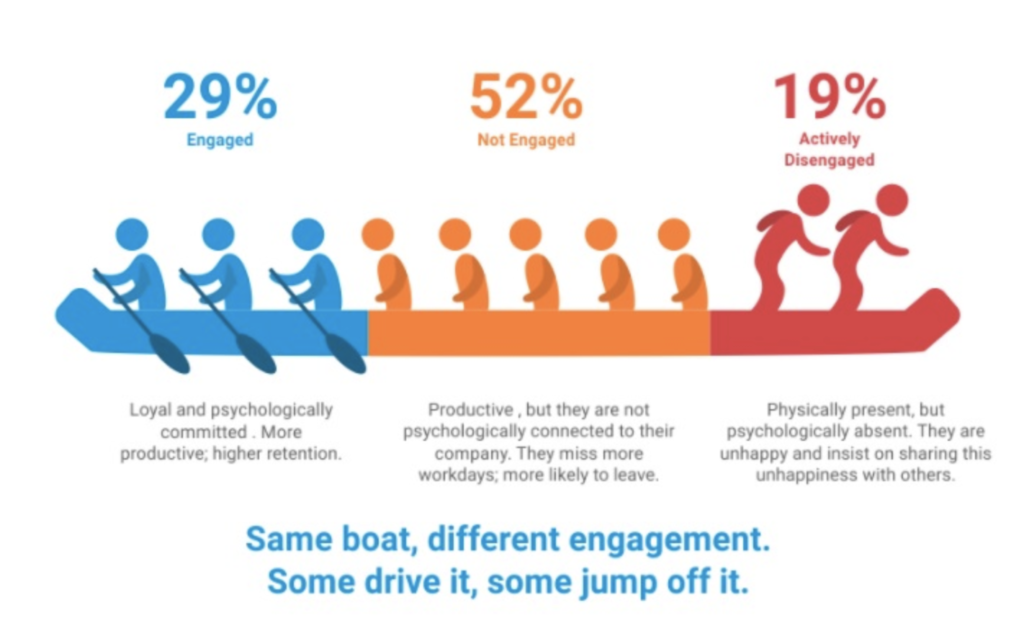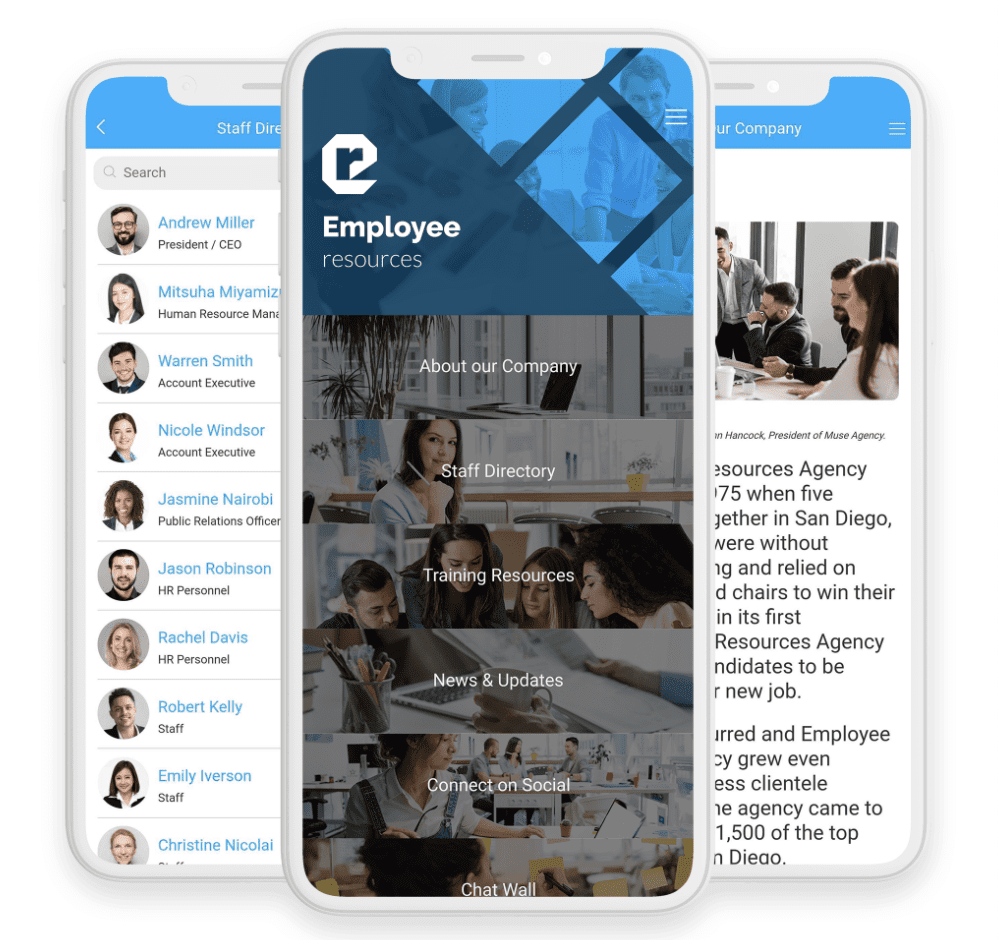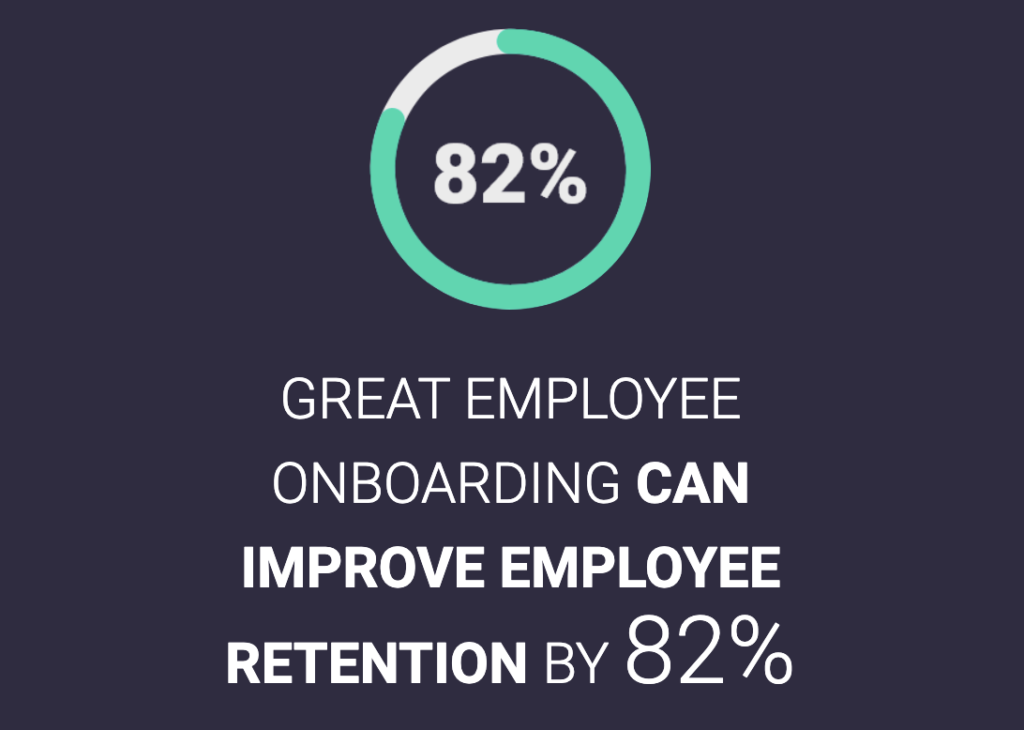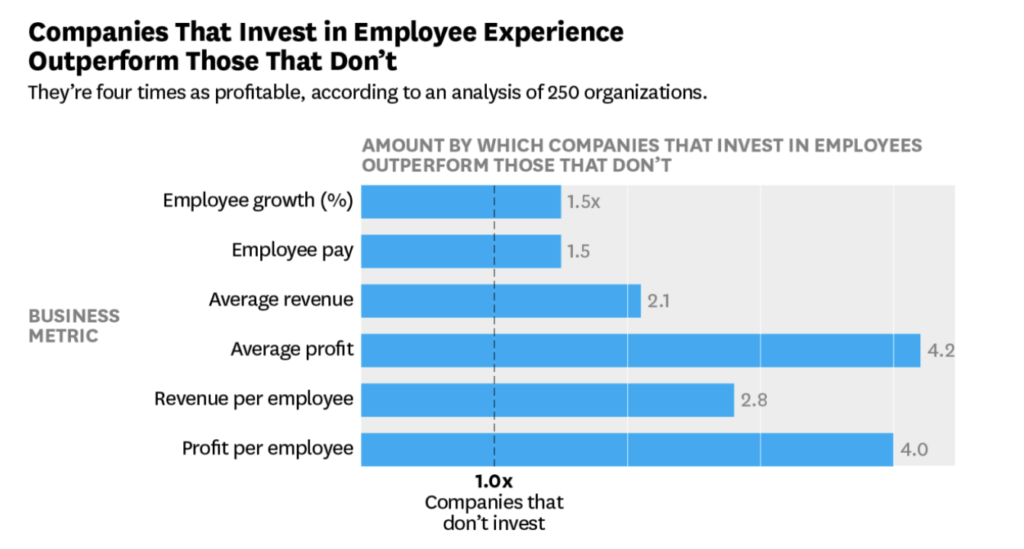10 Benefits of an Employee Communication App

Workplace communication is a vital part of any organization.
Employees must be able to share information and stay up-to-date with the latest company news, but it’s not always easy for them to do so in person or through email alone.
That’s why an employee communications app can be such a valuable tool. This blog post will focus on the top ten benefits you’ll experience using an employee app for internal communications.
Are you ready to transform the way your company communicates? Let’s dive in.
1. Communication Apps Establish Company Culture
Company culture is the foundation for any successful business. But creating the right company culture and getting everyone to buy in is much easier said than done.
Create a Mobile App for FREE with BuildFire
The best companies find ways to get everyone in the organization to work towards a common goal. By establishing the right culture and working environment in your company, your staff will be more productive, and you’ll reduce employee turnover.
So, what does a comms app have to do with company culture?
For starters, it immediately modernizes any company. Employees will see the organization as innovative and forward-thinking. Plus, you’re giving your staff the communication tools they need to succeed—which everyone appreciates.
But communication apps also facilitate the idea of open communication. Employees feel connected to their co-workers at all times, which helps build bonds and foster long-term relationships.
Comms apps break down barriers that prevent employers from communicating with each other and management alike. Regardless of the work environment, everyone has their mobile device within an arm’s reach at every hour of the day. So that company culture and communication ability never leave their side.
As an employer, you can create a custom workforce app that mirrors the type of culture you want to create. Everything from the color choices to images, videos, push notifications, and other app content can instill the type of culture that you’re trying to establish.
2. Comms Apps Drive Employee Engagement
Employee engagement can make or break the success of any organization. Whether you have five employees, 500 employees, or 5,000 employees, their level of engagement has a direct impact on your bottom line.
Unfortunately, this is something that many businesses struggle with. Only a small percentage of the workforce is actually engaged.

As you can see from the infographic, the vast majority of employees fall into the “not engaged” and “actively disengaged” categories. Less than one-third of all employees are engaged.
Disengagement is extremely costly. In fact, a disengaged employee costs roughly $3,400 for every $10,000 in salary. This translates to roughly $350 billion per year in lost productivity for the American workforce.
Apps can provide an immediate impact on employee engagement because they provide everyone with direct access to each other. Employees who work remotely or in the field automatically gain a connection to HR, management, and co-workers from the palms of their hands. These people no longer feel as isolated or disconnected as they do without the ability to communicate via apps.
Your employees are already using their mobile devices in the workplace. So it makes sense for them to use these tools to communicate—ultimately boosting engagement.
3. Internal Communications Apps Are a Single Source of Truth
Technology is rapidly evolving. But there’s so much great software out there that it’s become a bit overwhelming.
Here’s how many applications organizations of different sizes are using:
- Smaller companies with 1-100 employees — 102 apps
- Medium-sized companies with 101-1,000 employees — 185 apps
- Enterprise companies with 1,000+ employees — 288 apps
An internal communication app solves the problem here on multiple levels. It can eliminate the need for multiple applications by providing all company information in a single source of truth.
These apps can be used for:
- Human resources
- Pay stubs and employee benefits information
- New hiring onboarding
- Workplace safety and compliance
- Employee training and development
- Company news and announcement
- Employee schedules
- Live chat messaging
- Message boards
- Employee directory
- Office location information
The list goes on and on. For those of you who are already using other apps for certain employee-related or business-related tools, you can integrate your existing solutions with a custom communication app as well. The possibilities here are virtually limitless.

In turn, your employees won’t have to bounce back and forth between multiple platforms to get the information they need to succeed. This makes their lives easier while simultaneously increasing productivity across the board. Everything can be accessed from a single communications platform.
4. Communication Apps Appeal to the Modern Workforce
Your business always needs to stay one step ahead of the competition. This goes beyond just offering a better product, service, or marketing strategy—it includes recruiting top-level talent.
Younger generations like Millennials and Generation Z are the largest part of today’s workforce. Unlike generations of the past, these workers demand modern technology.
They want an enjoyable employee experience on multiple levels. If your company makes it easy for them to access HR information and communicate remotely, then you’ll have an edge over other businesses recruiting the same people.
The modern workforce is used to being on their smartphone at seemingly all hours of the day. They’re using these devices for both work-related and personal tasks. You need to give them tools that they want through channels that they’re comfortable using—and communication apps fit those criteria perfectly.
In addition to recruitment, employee apps will help you retain your staff for the long run as well. Employee turnover is extremely expensive, as the costs associated with hiring, onboarding, and training add up quickly.
But an app kills two birds with one stone. In addition to making your place of work more attractive to prospective hires, it also establishes company culture (refer back to benefit #1). Both of these lead to high retention.
Furthermore, the app itself can be used during the onboarding process—which has a direct impact on retention rates.

For more information, check out our post on the top employee management trends for the modern workforce.
5. Organizations Can Measure Communication Analytics
Today, the best business decisions are data-driven. But it’s impossible to make certain management decisions if you don’t have tools that can collect the appropriate data.
That’s where a comms app shines above other methods of workplace communication.
On the admin side, you can quickly see how the app is being used. What users are opening the app? How frequently do they open it? What features are they using the most?
Get Started With BuildFire Today!
Pick a template to start designing the app yourself, or let our professional design team build it for you.
- Mobile app development for iOS & Android
- No coding required
- 150+ pre-built features
- Unlimited customization
- 14 day free trial
You can use these analytics to double down on aspects that are driving communication and engagement. But you can also use the app to target employees that aren’t necessarily taking advantage of the app’s features.
For example, you might have certain company news announcements that drive more engagement than others. You can use this information to create more announcements that fit into this category instead of wasting time on ones that nobody cares about.
You can even use the app for employee polls, employee surveys, and other ways to gather feedback.
According to a recent study published by the Society for Human Resource Management, employees want to be heard.

Communication apps are an easy way for managers to collect feedback on a regular basis. You can even set up anonymous feedback so employees can give their opinions without feeling like they’ll be reprimanded for their opinions.
All of this provides valuable analytics to company leadership, so they can make appropriate changes and keep employee morale high.
6. Comms Apps Reduce the Need For Internal Email Communication
In terms of internal comms, email is slowly dying. They just don’t provide the instant response that workers seek in modern communication environments.
From a productivity perspective, email is crushing the way people spend their time. On average, just one employee sends and receives 112 emails per day. Employees are spending up to 23% of their workday on email.
Work emails create a false sense of productivity in the workplace. Workers feel like they’re getting stuff done as they declutter their inboxes, but that task isn’t really adding any value to big-picture initiatives. It’s just busy work that can be eliminated.
Communication apps offer a more quick and direct form of internal comms. They can even add a social-media-like experience in the workplace with features like an employee communication wall.
While there is definitely still a place for email at work, the way we use it needs to change. More and more companies are realizing this and trying to find ways to use email less. Employee communication apps are a viable alternative.
7. Employee Apps Provide Real-Time Communication on the Go
Modern employees are constantly on the move. Whether they’re on a job site, working remotely, or just grabbing a coffee in the neighborhood, they like the ability to stay connected with work while living their lives.
Traditional email and phone calls aren’t as convenient and realistic for these types of scenarios. Your staff doesn’t want to answer calls when they’re on the train commuting to the office or standing in line at a local coffee shop.
Management can use employee apps to send urgent messages and notifications to all employees, regardless of their physical location.
Let’s say you need to cancel a meeting or make urgent schedule changes. This can easily be communicated to some or all of your staff with push notifications.
8. Communication Apps Enable Collaboration For Deskless Workers and Remote Teams
Modern companies need to accommodate the deskless workforce.
As the name implies, these are people who aren’t sitting behind a traditional desk throughout the day. They might be working remotely, on job sites, meeting with clients on the road—the list goes on and on.
While 80% of the workforce is considered deskless, just 1% of enterprise software funding is allocated to this group.

There’s obviously a big problem with these numbers. Organizations are neglecting the largest and most important part of their workforce.
Deskless workers don’t have the luxury of a landline or desktop in front of their faces all day. They are behind the wheel of a vehicle or getting their hands dirty on the job. You can’t expect them to find a computer to get things done when they’re in these types of situations.
But smartphones are always around. Even from a construction site or client’s home, your deskless staff can stay connected and communicate with everyone from a mobile app.
From HR self-service to safety handbooks, training manuals, and company announcements, all of this can be accessed from anywhere.
9. Employee Communication Apps Are Easy to Use
The ease of use and user experience is really important to consider when you’re evaluating software solutions for your employees. You don’t want anything with a steep learning curve or tools that will make simple tasks harder than they need to be.
But the mobile app experience is seamless. Workers are used to using mobile apps for basically everything they do on a day-to-day basis. From social media to banking, food ordering, ride-hailing, and more, apps power the way we live. Why not leverage this in the workplace too?
According to the Harvard Business Review, companies that invest in the employee experience are four times more profitable than those that don’t.

In short, an app that improves the employee experience will have a direct impact on your bottom line.
10. Communication Apps Deliver a High ROI (Return on Investment)
Continuing on the subject of profits and bottom-line revenue, let’s talk about the ROI of an employee app. Obviously, you want to make sure that your decision to invest in employee communication will pay off.
We recently published an article on the ROI of an internal communications app.
I suggest reading that to help you calculate the potential ROI for your business. But here are some of the top highlights and areas where you’ll see the best return:
- Increased engagement
- Increased productivity
- Increased profits
- Lower employee turnover rates
- Improved relationships with management
- Reduce costs associated with workplace safety incidents
- Lower costs associated with training
Depending on the size of your organization, an app can save hundreds of thousands if not millions of dollars over time. You’ll begin to see the ROI almost immediately after implementing an app for internal comms.
Conclusion
If you want to improve the way your organization communicates internally, then it’s time to build an employee communication app. The benefits of this are numerous and will work for any size business—from a startup company with only one or two employees up through the enterprise level.
These apps streamline team communication and offer extensive functionality for your business.
Ready to get started?
BuildFire makes it easy for anyone to create a custom workforce app. Our software is easy to use, and it’s the fastest way to build a high-quality app for your business.
Start your free trial or contact our team to get started today.